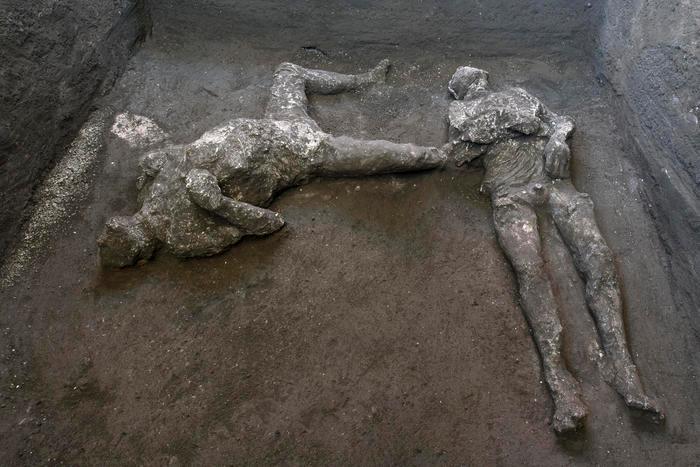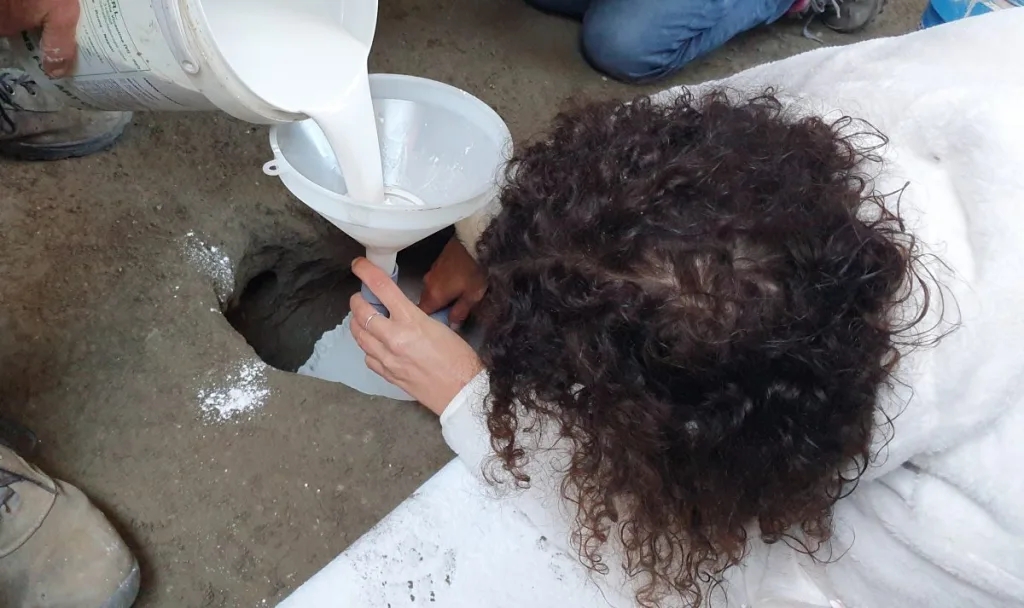In recent years, the discoveries at the Suburban Villa of Civita Giuliana, known as Domus del Sauro Bardato (the House of the Saddled Horse), have captured the world’s attention. This luxurious property from the time of Emperor Augustus is located just a few steps from the walls of ancient Pompeii, and 9 km away from Mount Vesuvius’s crater.
Within its ruins, archaeologists have found stables with the remains of three horses, including one with a wooden and bronze saddle and elegant adornments, two victims of the eruption, and a ceremonial carriage. Another globally acclaimed discovery was a room belonging to the slaves who worked on the estate.
What seems a mysery are the postures of the two deceased individuals found in the ruins. Their bodies are stretched out, their clothing is folded up to their chests, and their legs are bare. The younger man’s genitalia are almost exhibitionistically pointing upwards, and both men’s arms are resting on their chests.

The identities of the two men
Preliminary studies suggest they are the nearly intact bodies of a 40-year-old and his young slave. Both were found in the Kryptoportikus, a semi-subterranean passageway beneath one of the villa’s terraces. The older man was wearing a woolen coat, a crucial detail. It is interpreted as evidence that Vesuvius’s eruption occurred in the fall. Medieval copies of the letters of young Pliny had previously interpreted as saying that the eruption happened on August 24, 79 AD, an assumption long disputed.
The older man is believed to have been a military commander or high magistrate, perhaps a member of the Mummii family, a distinguished Roman family from the imperial era. The two almost complete bodies, now on display in Pompeii’s new museum, were immortalized by the plaster casts made from the voids left in the pyroclastic ash layer. This technique, developed by Giuseppe Fiorelli in 1863, had previously failed in the 1990s but this time revealed cramped postures, naked legs, arms folded on the chest, and heads arched backward. Even the fabric of their coats and togas is discernible.



The peculiar postures
The postures of the men find their explanation in how they died. Initial studies have identified the moment of their death: the second day of the eruption, on the morning of October 25 (based on the new dating proposal). The victims were found in the Kryptoportikus, an underground room beneath a terrace, where they likely thought they would be better protected. Initially, this was probably the case at the beginning of the eruption.
After Vesuvius’s violent explosion on October 24, ash, lava, and pumice rocks were ejected. It was so intense that it was dangerous to venture outside. According to Pliny, residents even tied pillows to their heads for protection. Then so much ash fell that doors could no longer be opened.
This might be a reason why the men didn’t escape with the horses. They wouldn’t have been able to progress in the ash. What ultimately cost them their lives was however a multiple break down of the eruption column, leading to pyroclastic waves and surges.
A surge cloud is a mix of gas, ash, and rock dust ejected during a volcanic eruption. Surges differ from pyroclastic flows in that they have a lower density and stay closer to the ground. They follow the surface and terrain faster than a high-speed train, are boiling hot, and extremely dangerous, reaching speeds of 100 meters per second.
The area affected by pyroclastic waves and surges includes everything within 12 km of the volcano. The residents of the villa, only 9 km away, were condemned to death.
They were likely swept away by the pyroclastic surge at 9 am on the second day of the eruption, as the boiling cloud reached Pompeii, completely destroying the upper floors of the estate. They probably died from thermal shock, as shown by their contracted limbs, hands, and feet.
In Pompeii itself, the city walls halted the first mudflow before the city was also submerged. In the Villa of the Saddled Horse, the pyroclastic wave carried away the dead. It pushed up their clothing to their chests and swirled them around. It also broke the walls perpendicular to the wave, yet flowing along the parallel corridors.
What appears to be statues today are, in truth, people who died in agony under terrifying circumstances.
The initial excavations in the villa date back to 1907-1908 and were conducted by Marquis Giovanni Imperiali, the property owner at the time. However, after the excavations, the Marquis had these rooms refilled without leaving adequate documentation. The current excavations, entirely funded by the Pompeii Park with one million euros, are the result of a joint operation with the Public Prosecutor’s Office of Torre Annunziata, Public Prosecutor Pierpaolo Filippelli, and the Carabinieri to stop grave robbers who had left extensive traces of their activities here.


Leave a comment